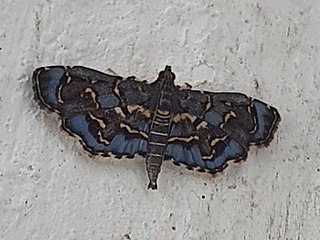Procymbopteryx is a monotypic moth genus of the family Crambidae erected by Eugene G. Munroe in 1961. Its only species, Procymbopteryx belialis, was first described by Herbert Druce in 1899. It is found in the Mexican state of Guerrero and the US state of Arizona.
Eufernaldia cadarellus is a moth in the family Crambidae. It was described by Herbert Druce in 1896. It has been found in Mexico and the US states of Arizona, Texas and Utah.
Abegesta remellalis, the white-trimmed abegesta or white-trimmed brown pyralid moth , is a moth in the family Crambidae. It was described by Herbert Druce in 1899. It is found in Mexico and the south-western United States, where it has been recorded from Arizona, California and New Mexico.
Dichogama prognealis is a moth in the family Crambidae. It was described by Druce in 1895. It is found in Costa Rica and Ecuador.
Blepharomastix crusalis is a species of moth in the family Crambidae. It was described by Herbert Druce in 1895. It is found in Veracruz, Mexico.
Bocchoris darsanalis is a moth in the family Crambidae. It was described by Herbert Druce in 1895. It is found in Mexico (Jalapa) and Panama.

Eurrhyparodes splendens is a species of moth in the family Crambidae. It was described by Herbert Druce in 1895. It is found in the US from Arizona and Texas through the Mexican states of Xalapa, Veracruz, Morelos, Guerrero and Yucatán to Guatemala and Costa Rica.
Hileithia apygalis is a species of moth in the family Crambidae. It was described by Achille Guenée in 1854. It is found in Colombia, Panama and Tabasco, Mexico.
Hileithia rhealis is a species of moth in the family Crambidae. It was described by Herbert Druce in 1895. It is found in Guerrero, Mexico.
Meroctena zygialis is a moth in the family Crambidae. It was described by Herbert Druce in 1899. It is found in Xalapa, Mexico.
Pantographa gorgonalis is a moth in the family Crambidae. It was described by Herbert Druce in 1895. It is found in Guerrero, Mexico.
Pantographa idmonalis is a moth in the family Crambidae. It was described by Herbert Druce in 1895. It is found in Morelos, Mexico.

Pantographa suffusalis is a species of moth in the family Crambidae. It was described by Herbert Druce in 1895. It is found in Mexico and Costa Rica.
Psara prumnides is a species of moth in the family Crambidae. It was described by Herbert Druce in 1895. It is found in Mexico, Costa Rica, Honduras and Panama.
Salbia tremulalis is a moth in the family Crambidae. It was described by Herbert Druce in 1899. It is found in Orizaba, Mexico.

Syllepte angulifera is a moth in the family Crambidae. It was described by Herbert Druce in 1895. It is found in Guatemala, Costa Rica, Panama and Mexico.
Syngamilyta samarialis is a moth in the family Crambidae. It was described by Herbert Druce in 1899. It is found in Costa Rica and Colombia.
Neopreptos clazomenia is a moth in the family Eupterotidae. It was described by Herbert Druce in 1886. It is found in Panama.
Neopreptos marathusa is a moth in the family Eupterotidae. It was described by Herbert Druce in 1886. It is found in Costa Rica.
Scopifera antorides is a species of moth in the family Erebidae. It was described by Herbert Druce in 1891. It is found in Guatemala, Costa Rica and in Mexico in Durango and Xalapa.


